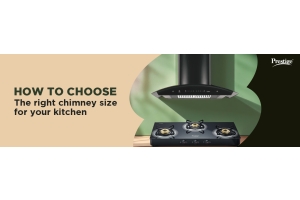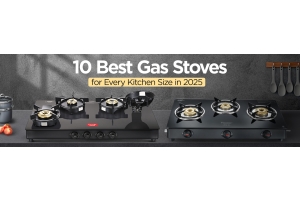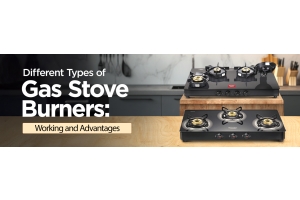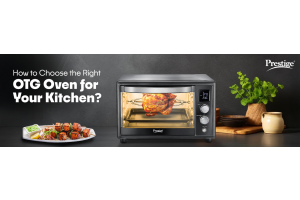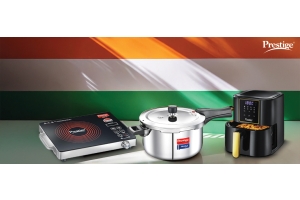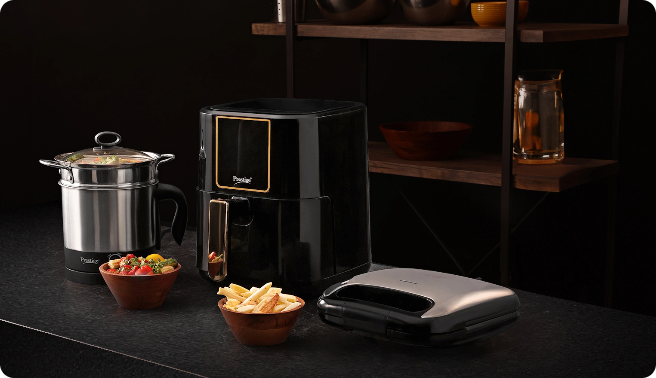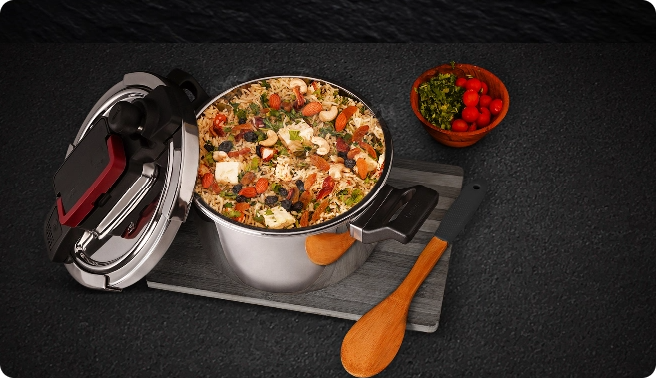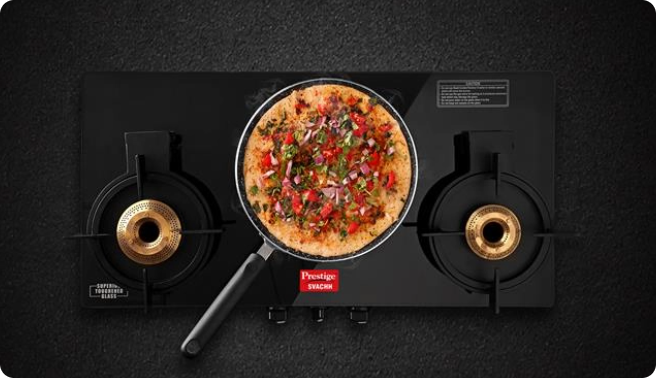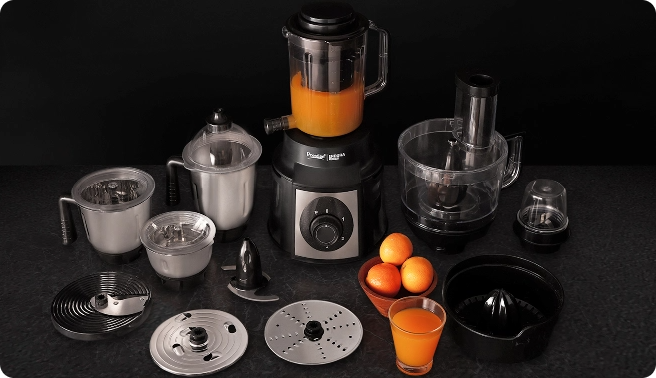Kitchen chimneys often don’t make the priority list when setting up a house, but they play a crucial role in creating a healthy and comfortable cooking environment. We hope this article convinces you to invest in a chimney to revamp your kitchen.
It all began when people used to make small holes in the ceiling as an outlet for smoke from cooking. However, this made the top walls dark and greasy. You might notice a similar black, greasy buildup around kitchen exhaust fans. However, a modern kitchen is designed to efficiently remove smoke, odour, and fumes, enhancing the cooking experience.
Why Does Kitchen Chimney Size Matter?
A kitchen chimney is far more than an appliance; it is an investment in hygiene, efficiency, and stenography. Finding the correct size is vital to keeping your kitchen clean and smoke-free.
- Effective smoke extraction – If you have a properly sized chimney above your stove, it will create suction seamlessly and not allow smoke and grease to float freely. A chimney that is too small leaves gaps, while one that is too big has no value added and also wastes energy.
- Improved indoor air quality – When cooking, the oil will create fumes and pollutants that can significantly degrade indoor air quality. Having a properly sized chimney will remove harmful indoor air quality emissions safely and efficiently while reducing risks to respiratory systems and maintaining a fresh kitchen space.
- Optimised performance – A chimney should sit perfectly above your stove and match the size of your kitchen space to perform correctly. A chimney that is too small will struggle to create adequate suction, and one that is too big will waste excess power creating suction. A chimney that fits optimally will perform well and last longer while remaining energy efficient.
- Enhanced kitchen – Next to performance, a chimney will complement the appearance of your kitchen. Chimneys measuring 60 cm or 24 inches fit ideally with a 2-burner stove, whereas 90 cm or 35 inches size chimneys will better fit a 3-burner stove and kitchens that have more space.
A chimney of proper size will ensure effective ventilation and hygiene, added efficiency for your kitchen, and complete the overall look of your kitchen space for the total benefit and enjoyment of your kitchen. Are you having trouble picking which one is the best chimney for you? Check out all the Chimneys by Prestige here.
Key Factors to Consider When Choosing a Chimney Size
Kitchen Size and Chimney Dimensions:
The kitchen's size is a crucial factor in the choice of a chimney. In small kitchens (less than 150 sq. ft.), a 60 cm chimney is enough to cover the cooking area without making the kitchen feel too full. Meanwhile, kitchen spaces above that area or open layouts will require a 90 cm chimney for better coverage for suction to remove smoke and odours. Proper chimney sizing will keep unwanted smoke from gathering and ensure fresh air in the kitchen.
Stove Size and Chimney Width:
Your stove's width is a determining factor for the chimney to function best. A 60 cm chimney paired with a 2-burner stove offers targeted suction for those smaller cooking areas. If you have a 3- to 5-burner stove, a 90 cm chimney is just right because it will cover the entire stove width and efficiently suck out smoke and grease. The bottom line is the chimney must match the size of the stove to ensure complete ventilation and avoid grease settling on the surfaces around it.
Cooking Style and Suction Capacity:
Different cooking styles demand different suction capacities. If your style involves light boiling, steaming, or occasional frying, a chimney with a 799 CFM or less suction would be enough. On the other hand, heavy-duty cooking involving deep frying and grilling with strong spices—almost an everyday affair in India—would require a chimney with 1000 to 1199 CFM being the only effective option possible to extract smoke and keep the kitchen cleaner. Choosing suction power is a big factor in hygiene and air quality, said to be based on your cooking style.
Types of Kitchen Chimneys by Prestige and Their Applications
Prestige has categorised its chimneys into various segments to suit different kitchen needs.
Air Suction Capacity: TTK Prestige chimneys are categorised according to their suction power for various cooking needs. There are 5 models which are good with suction up to 799 CFM and light to moderate cooking. In the case of heavy-duty Indian cooking, 14 models with suction capacity between 1000 and 1199 CFMs take care of smoke and grease removal.
Body Type: The chimney comes in different finishes for durability and aesthetic appeal. 8 models flaunt powder-coated bodies, giving a sleek and resistant surface; 1 model is made of stainless steel for durability and a classic appearance.
Ignition Type: Prestige offers 23 models with manual ignition for an easy and dependable means of operating the chimneys without any electrical parts.
Material: Chimneys are made of various materials for strength and aesthetics. 12 models have a powder-coated finished model, 10 models of the stainless-steel chimney have a modern and durable design, and one is made with aluminium that has light weight and durability.
Mounting Type: Most Prestige chimneys are wall-mounted. 19 models ensure efficient utilisation of space and easy installation options across various kitchen designs.
Power: Different power ratings cater to diverse performance requirements. 11 models with 180W ensure an energy-efficient performance; the other models vary between 200W, 233W, 250W, and even a mighty 650W model to ensure effective suction according to kitchen sizes.
Cost: From ₹1,000 to ₹2,000 for the budget variety to anything above ₹19,000 (Prestige Provo 900 Kitchen Hood Chimney) for the high-end choice, Prestige chimneys are available in many different price ranges. Several mid-price models between ₹7,000 and ₹18,000 provide options based on their features and performance.
Product Sub-Type & Types: All 23 models fall under the category of kitchen hoods/chimneys and thus concentrate solely on solutions for kitchen ventilation.
Shape: 23 models available in the T-type shape from Prestige give a modern design while ensuring maximum suction efficiency.
Size: There are two size options available – a 60 cm size suitable for 2-burner stoves in smaller kitchens or a 90 cm size ideal for 3+ burner stoves in big kitchens.
Types of Kitchen Chimneys for Different Layouts
Each type of chimney is designed for different kitchen layouts and stove placements. Here are the main types:
- Wall Mount Chimney – the very traditional kitchen is made according to the stove; therefore, it can be mounted against a wall, offering effective smoke extraction.
- Built-in Chimney – This would be very sleek and space-saving, blending very well with the kitchen cabinets, thus an ideal choice for a modular kitchen.
- Island Chimneys – The best aligned with island kitchens, centralises the stove and, thus, is properly ventilated from all sides.
- Downdraft Chimneys – A hidden, retractable model that stays inside the countertop and rises when needed, ideal for ultra-modern kitchens.
- Telescopic Chimney – Features a retractable design, expanding when in use and folding away to save space when not needed.
Common Mistakes to Avoid When Selecting a Chimney Size
Choosing the wrong chimney size can affect its performance and longevity.
- Here are some mistakes that can be corrected:
- Choosing a chimney that is smaller than the stove – it reduces its ability to capture smoke and fumes effectively.
- Never ignore suction power – ones with lower power provide inadequate ventilation, especially for heavy cooking.
- Overlooking maintenance needs – Results in grease buildup and reduced efficiency over time.
- Not considering future kitchen expansion – Makes the chimney inadequate if you upgrade your stove or cooking space.
Choosing the Best Chimney Fit
The following key steps will guide you to select the right chimney for your kitchen.
- Before purchasing a chimney, measure the width of your stove to ensure that the chimney matches or only slightly exceeds the stove dimensions.
- Assess your kitchen’s ventilation system and spatial layout to maintain proper airflow.
- The optimum suction power of your chimney depends on cooking styles, with higher settings needed for deep frying and grilling, while light cooking requires moderate settings.
- Choose chimney models that offer auto-clean features to ensure easy maintenance while paying attention to noise levels.
For more information you can read How to choose kitchen chimney
Conclusion
Kitchen chimney selection directly impacts hygiene and air quality while adding to visual kitchen appeal. Investing in the right kitchen chimney for effortless cooking requires evaluating size, suction power and maintenance needs.
Frequently Asked Questions (FAQs)
Q1. What should I do if my kitchen chimney makes noise?
A. Check for loose parts or blockages and/or consult a technician if the issue persists. Seek professional assistance if the kitchen chimney continues to operate improperly.
Q2. How can I prevent grease buildup in my kitchen chimney?
A. To avoid grease accumulation in your kitchen chimney, you should clean the filters and chimney hood on a regular basis and consider using a grease trap or an auto-clean system. Clean the filters and chimney hood regularly. For optimal performance, use a grease trap or opt for an auto-clean chimney.
Q3. What should I consider before buying a kitchen chimney?
A. Evaluate suction power based on your cooking style and kitchen size before purchasing a kitchen chimney. The suction power of your kitchen chimney needs to sync well with both the size of your kitchen area and your cooking habits. Ensure your kitchen chimney matches or is a bit wider than your stove dimensions. Choose models that operate quietly to reduce noise levels. Choose a chimney that offers easy maintenance with auto-clean features.
Q4. Why should I choose a TTK Prestige kitchen chimney?
A. TTK Prestige chimneys offer powerful suction, advanced auto-clean technology, and stylish designs to ensure a smoke-free, efficient, and modern kitchen experience.
Q5. How many types of kitchen chimneys are available?
A. There are five main types of kitchen chimneys available—wall mount, built-in, island, downdraft, and telescopic. Each type suits different kitchen layouts, providing flexibility to consumers.







